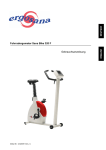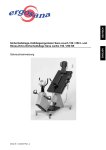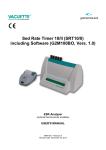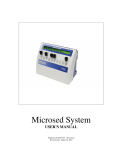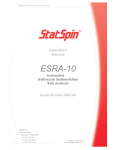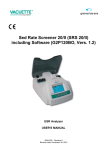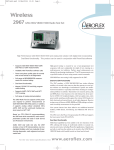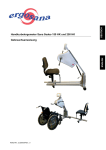Download Ergosana 250 REHA User guide
Transcript
Seat ergometer Sana comfort 150/250/REHA User Guide Article no.: 2.520064 rev.: b Sana comfort 150 and 250 REHA CE Conformity Declaration ergosana GmbH herein declare that the products of the ergometer system Sana comfort 150/250/REHA have been designed and manufactured in accordance with the relevant requirements of the EC directive 93/42/EEC. This declaration loses its validity if the above devices are modified without ergosana‘s consent. The medical products are checked by the notified body DEKRA and they bear the CE mark CE 0124. 0124 Manufactured by: ergosana GmbH Truchtelfinger Str. 17 D-72475 Bitz Harald Neukirchner Quality manager Article no.: 2.520064 rev.: b Page 2 of 24 Sana comfort 150 and 250 REHA Table of Contents 1 General......................................................................................................4 1.1 Intended use ....................................................................................... 4 1.2 Contra-indication.................................................................................. 4 1.3 Features ............................................................................................. 4 1.4 Instruction .......................................................................................... 4 1.5 Maintenance ........................................................................................ 4 2 Product description ...................................................................................5 2.1 Unit Components.................................................................................. 5 2.2 Accessories.......................................................................................... 5 2.3 Potential equalisation ............................................................................ 5 2.4 Technical data...................................................................................... 6 2.5 Signs and symbols................................................................................ 6 2.6 Safety notes ........................................................................................ 7 2.7 Eliminating electromagnetic interferences ................................................ 7 3 Installation................................................................................................8 3.1 Location .............................................................................................. 8 3.2 Assembly instructions ........................................................................... 8 3.2.1 Unpacking and assembling ......................................................... 8 3.2.2 Seat adjustment ....................................................................... 8 3.2.3 Connecting the blood pressure cuff .............................................. 8 3.2.4 Mains connection....................................................................... 8 4 Unit components .......................................................................................9 4.1 Control panel ....................................................................................... 9 4.2 Rotational speed display on the control panel ........................................... 9 4.2.1 Panel interfaces for 250 ............................................................. 9 4.2.2 Keys and display ..................................................................... 10 4.2.3 Setting the language ............................................................... 11 4.3 Blood pressure cuff for 250 .................................................................. 11 5 Safety notes ............................................................................................12 5.1 Precautions during operation................................................................ 12 5.2 Safety precautions when operating with other devices ............................. 12 5.3 Maintenance safety precautions ............................................................ 12 5.4 Interference ...................................................................................... 12 6 Start-up and initial preparation ...............................................................13 6.1 Blood pressure recorder for 250 ........................................................... 13 6.2 Applying the cuff for 250 ..................................................................... 13 7 Ergometry................................................................................................14 7.1 Defining the automatic load programs ................................................... 14 7.2 Recommended settings ....................................................................... 16 7.3 Remote operation ............................................................................... 17 7.3.1 Explanation ............................................................................ 17 7.3.2 Prerequisites .......................................................................... 17 7.4 Training program (option).................................................................... 18 7.4.1 Training with constant heart rate (Pulse-Steady-State) ................. 18 7.4.2 Configuring a training program on the ergometer......................... 18 7.5 Rehabilitation version.......................................................................... 20 7.5.1 Additional control elements....................................................... 20 7.5.2 Options for the data transfer ..................................................... 21 8 Maintenance and fault clearing................................................................22 8.1 Checking the measuring technology ...................................................... 22 8.2 Cleaning the device ............................................................................ 22 8.3 Cleaning the blood pressure cuff for 250 ................................................ 22 8.4 Checking and setting the supply voltage ................................................ 22 8.5 Changing a mains fuse ........................................................................ 23 8.6 Disposal information ........................................................................... 23 9 Appendix .................................................................................................24 9.1 Technical Customer Service and Sales Locations ..................................... 24 Article no.: 2.520064 rev.: b Page 3 of 24 Sana comfort 150 and 250 REHA 1 General The Sana comfort 15/ 250/REHAa seat ergometers are high-performance, state-of-the-art ergometers. Sana comfort 250 is equipped with a blood pressure measurement module, located in the ergometer's control console. The devices meet the highest quality standards for accurate physical exertion tests to conduct measurements in cardiovascular and pulmonary function diagnostics. Thanks to the comfortable seat and the special sitting position allowing comfortable pedalling, this ergometer is suitable for long-term training as well as adipose patients. 1.1 Intended use Ergometer Sana bikes are bicycle ergometers that are intended for defined exercise ergometry during a patient's examination and therapy. These products are used in practices, clinics, therapy and rehabilitation centres. The ergometers are operated by physicians and medical personnel. 1.2 Contra-indication In the event of the following contra-indications, NO exercise test must be performed: in the case of acute cardiac infarction or unstable angina pectoris, serious hypertonia at rest, carditis, insufficiency of the heart, serious valvular heart defect, serious cardiac arrhythmia at rest, aortic aneurysm or other manifest cardiovascular diseases. 1.3 Features The following characteristics make the unit exceptional: • • • • • • • • • • • • • • • • • Attractive design Comfortable mounting and dismounting Stable steel construction, compact drive unit Stable clamps on saddle and handle bars Impact- and scratch-resistant casing, easy to clean New, high-performance control electronics Graphic display featuring visual representation of ergometry data Easy operation via menu mode Remote operation – personalised programs – training programs Disturbance-free blood pressure measurement Performance range from 1 to 999 watts Guaranteed accuracy (error factor < 3% in the independent rpm range) Nearly noiseless drive unit Pleasant pedalling sensation due to large gyrating mass Galvanically isolated RS 232 interface, secure data transfer Reha version with USB bus Reha version with ECG amplifier and suction electrode system 1.4 Instruction Before the initial operation, carefully read through this user guide, paying special attention to the warnings and safety instructions. 1.5 Maintenance This is a low-maintenance device. You will find detailed maintenance instructions in section 8. Article no.: 2.520064 rev.: b Page 4 of 24 Sana comfort 150 and 250 REHA 2 Product description 6 2.1 1. 2. 3. 4. 5. 6. 7. 8. 2.2 1 Unit Components Handlebar Control console Locking lever to adjust the back rest Handlebar on the seat Arrow keys for horizontal seat adjustment Back rest Base adjuster for height adjustment Mains connector, potential equalisation, RS-232 interface Accessories 7 5 2 4 3 Every device comes with: 2.3 Power cable with European plug Blood pressure cuff for 250 User guide Inspection report 8 Potential equalisation A standard potential equalisation stud is located on the rear panel, next to the power connection unit. It is marked with a green/yellow information sign. Using an earth cable, the ergometer can be connected with the potential equalisation of the examining room, which serves as a common earth point for all other mains-operated devices in the room to ensure that all devices have the same earth potential. Article no.: 2.520064 rev.: b Page 5 of 24 Sana comfort 150 and 250 REHA 2.4 Technical data Bicycle ergometer with blood pressure measurement in accordance with DIN 13405 /DIN VDE 0750-238. Braking principle Computer-controlled brakes with permanent measurement of torque. Braking performance is independent of revolutions per minute. Power range 1 to 999 watts Load range independent rpm range 20 till 999 Watts Range of revolutions 30 to 130 rpm for pedals Load precision 3%, not less than 3 watts (in the independent rpm range) Load parameters 1. In keeping with set internal load program 2. Parameters from external master unit over interface, in 1 watt steps. 3. Manual in 5-watt and 25-watt steps Load software 5 freely programmable ergometry programs 1 automatically controlled pulse-steady-state program Time intervals 1 min to 99 min Display Graphic LCD with 320 x 240 pixels, CCFT background lighting Blood pressure measure- Indirectly, with a specific, modified measuring system based on R-R, ment for 250 and computer analysis including maximal suppression of artefacts during ergometry. Automatic deflation rate of 3 mmHg/pulse. Measuring range 40 - 300 mmHg. Pulse measurement With a blood pressure unit or an optional Polar pulse monitoring system; pulse rate 35 - 240 Horizontal seat adjustment Continuously variable on a slope, special seat for heights between 150 and 210 cm, electric drive. Maximal permissible 250 kg patient weight Long-term accuracy Torque equalisation at any time with weight Power supply 230 VAC 50–60 Hz, 115 VAC 50–60 Hz The unit is suitable for use in networks according to CISPR 11, group 1, class B. Electric inputs/outputs RS-232 (galvanically isolated) Base dimensions 40 x 130 cm Weight 74 kg 2.5 Signs and symbols In this section, the signs and symbols used in connection with this device are explained: Mains operated, alternating current Potential equalisation connection (earth) BF classified component Warning! Follow the instructions in the documentation. 93/42/EEC for medical products 0124 DEKRA Article no.: 2.520064 rev.: b IPX0 Protection class of the casing: IPX0 Page 6 of 24 Sana comfort 150 and 250 REHA 2.6 Safety notes Safety precautions when operating with other devices Portable communication devices, HF radios and devices labelled with the symbol tromagnetic radiation) can affect the operation of this device (see section 2.7). 2.7 (non-ionic elec- Eliminating electromagnetic interferences 1. The unit is only designed for operation in the following electromagnetic environment: Radio frequency emission according to CISPR 11, group 1, class B. 2. 3. 4. 5. Group 1 means that the ergometer exclusively uses HF energy for its internal function. The HF emission is therefore very low and unlikely to disturb electronic devices in the vicinity. Class B means that the ergometer is suitable for use in any facilities including residential areas, even if it is directly connected to the public mains that also supplies residential buildings. The general electromagnetic environment with regard to the device's electromagnetic immunity is defined as follows: the voltage corresponds to the typical business or hospital environment, and the humidity is at least 30%, especially if the floors are synthetic. If disorders should nevertheless occur, especially in the vicinity of devices labelled with the symbol "non-ionic electromagnetic radiation", check the recommended minimal distance according to the following table. More information is given in the service manual. Recommended safety distances between portable and mobile HF telecommunication devices and the ergometer The ergometer is designed for operation in an electromagnetic environment with controlled HF disturbance. The user can help avoid electromagnetic interferences by keeping the minimum distance between portable and mobile HF telecommunication devices (senders) and the ergometer, depending on the output performance of the communication device as indicated below. HF source Rate Rated power P of the sender [W] Distance 885–887 MHz 0,01 0,23 Cordless DECT telephone, WLAN, UMTS mobile phone 1880-2500 0.25 1.17 Mobile phone, USA 850/1900 1,2 1.8 850/900/1800 1 2.3 900 2 3.3 Walkie-talkie (rescue services, police, fire brigade, maintenance services) 81-470 5 2.6 Mobile radio system (rescue services, police, fire brigade) 81-470 100 11.7 [MHz] Microcellular phone CT1+, CT2, CT3 Mobile phone, GSM850, NMT900, DCS 1800 Mobile phone, GSM 900 Article no.: 2.520064 rev.: b [m] Page 7 of 24 Sana comfort 150 and 250 REHA 3 Installation 3.1 Location Install the device in a suitable position (refer to safety instructions in section 5). The unit should not be stored or operated in wet, moist or dusty surroundings. Nor should the unit be exposed to direct sunlight or other sources of warmth. The unit should not come into contact with acidic vapours or fluids. The unit should not be placed near X-ray units, large transformers or electrical motors. There must be a distance of at least one meter between the unit and the mains network. 3.2 3.2.1 Assembly instructions Unpacking and assembling Install the control panel after unpacking the unit. In order to do so, insert the two tabs on the back of the control panel into the handle bar pipe and press them downward to their stop. The operator's side should usually face the front so that the display can be seen by the person operating the machine. Connect the potential equalisation cable to the flat plug at the back of the control panel. Connect the main plug with the connecting socket. Fasten the rear cover with 4 screws. Remove the seat's transport protection. With the help of the base adjustor on the rear lower side of the ergometer, adjust the device so that it is flush with the floor. The ergometer is then fully stabilised. 3.2.2 Seat adjustment Mechanical seat adjustment The seat is infinitely variable horizontally in order to accurately adjust the distance to the pedals. The seat can be adjusted for persons between 150 cm and 210 cm in height. The handle next to the control console ensures safe grip while positioning the feet on the pedals. A ball-grip lever is used to adjust the sitting position. This lever is located on the right hand side, underneath the seat, and is easily accessible. Press the ball handle downwards to unlock the seat break, and adjust the seat until the correct sitting position has been found. Pull the lever upwards as far as it will go to lock the seat. The seat construction is designed for patients weighing up to 250 kg. Motorised seat adjustment Adjust the seat by use of the arrow buttons. 3.2.3 Connecting the blood pressure cuff The interfaces for the air tube and the microphone are located underneath the seat's guiding rail. Connect the blood pressure cuff by screwing the hose connection onto the joining nipple and inserting the microphone plug in the socket next to it. 3.2.4 Mains connection Establish potential equalisation (see section 2.3) and plug the supplied power cable into an earthed socket. As the device is preset to the local mains voltage (refer to section 8.4), you can switch it on using the main switch at the front. Article no.: 2.520064 rev.: b Page 8 of 24 Sana comfort 150 and 250 REHA 4 Unit components 4.1 Control panel The control panel is mounted on the upper side of the control panel carrier with two plug-in tabs. During normal operation, the display should be facing the examiner. It is possible to turn the console 180 degrees for special applications such as patient training, etc., so that the patient can reach the control elements and see the display. All of the control electronics for ergometer operation and blood pressure measurement are located in the control panel. A backlit LCD featuring the complete range of information is located on the front side under a foil keyboard with a see-through window. The control elements for the adjustment and operation of the ergometer are located on the foil keyboard. The connections for the blood pressure cuff are located on the underside of the Sana comfort 250. In couch ergometers, they contain an extension line. The cuff socket is located on the couch's upper edge. An LCD on which the patient can see the number of pedal rotations per minute is located on the panel's upper side. 4.2 Rotational speed display on the control panel n = crank rotations per min U min–1 4.2.1 Panel interfaces for 250 The extension line for the blood pressure cuff is connected at the bottom of the control panel. 1. 2. Cuff connection Microphone connection 1 Article no.: 2.520064 rev.: b 2 Page 9 of 24 Sana comfort 150 and 250 REHA 4.2.2 Keys and display The LCD with graphics capability, 320 x 240 pixels and a surface of 100 mm x 75 mm is located on the front of the control panel. It is covered by a foil keyboard with a see-through window. The display shows all configuration and operating procedures. During the exercise testing, all current measurement data is shown in the display in alphanumeric and graphic forms. It is thus especially easy to monitor exercise testing. The cursor can be moved through the selection menu in the display with the up and down arrow keys. The right and left buttons on the control panel have been arranged so that the function executed by the corresponding key is shown directly above the key on the lower side of the display. 5 1 For 250 2 next next 3 ok 3 4 1 2 3 4 5 = = = = = Blood pressure measurement key Stop/quick pressure release key Confirmation key "Up" and "down" cursor keys LCD display Article no.: 2.520064 rev.: b Page 10 of 24 Sana comfort 150 and 250 REHA 4.2.3 Setting the language The preset menu language is “deutsch”. To change the language, highlight the “Einstellungen” menu option using the "ab” arrow, and confirm with “OK”. In the “Einstellungen” menu, select the “Sprache” option and confirm with “OK”. Then select the desired language using the “auf” or “ab” arrow, and confirm with “OK”. The menu is now displayed in the selected language. 4.3 Blood pressure cuff for 250 The standard blood pressure cuff (order no. 24-10-301) has Velcro fixing. It can be used for arms up to 45 cm in diameter. A larger cuff (order no. 24-10-321) is available for larger arm diameters. A microphone is installed in a microphone pocket on the inside of the cuff. It serves the transmission of the blood pressure sound. The connection cable with an air and a microphone connection is 110 cm long. This is a sufficient length. It ensures that the cable does not dash against the ergometer during pedalling. This is to prevent unnecessary artefacts that might result in inaccurate blood pressure measurement. Longer cables (200 cm) are available but it is imperative to make sure that artefacts are prevented. Cleaning: The cuff should only be washed with soapy water and immediately dried off again. The surface of the microphone pocket is waterproof. Make sure that no moisture penetrates the opening of the microphone pocket. If this occurs repeatedly, it may result in damage to the microphone. Article no.: 2.520064 rev.: b Page 11 of 24 Sana comfort 150 and 250 REHA 5 5.1 Safety notes Precautions during operation Before using the unit, make sure that the medical product consultant has conducted an introduction in regard to function and safety precautions. The unit should not be used if there are any doubts as to its being isolated from earth or the suitability of the power cable. The supplied power cable meets valid regulations for medical applications. The unit is not intended for use in wet rooms, outdoors or in areas where there is danger of explosion. Before its initial operation, the device must be adjusted using the base adjustors at the back to provide absolute stability. When the saddle is exchanged, make sure that the screws at the saddle are tightened hard enough so that the saddle cannot be moved on the saddle pipe. To move the handle bars and saddle, loosen the clamps and retighten them well afterwards. It is recommended to position the clamps with the levers positioned vertically downward. Secure clamping is ensured when the handles are then again turned to this position during the adjustment procedure after every movement. The holding straps on the pedals must fit perfectly across the upper side of the shoe and be fastened with a Velcro strap. 5.2 Safety precautions when operating with other devices When several devices are coupled, there is a risk that the leakage currents may add up. Interface RS 232, which can be used for communication with other devices, is isolated to ensure the patient’s safety. External devices may only be connected with the interface cables supplied by ergosana. 5.3 Maintenance safety precautions The device must be turned off and the power plug disconnected before cleaning with liquid cleaning agents. Use only standard cleaning agents for plastic surfaces. The unit may only be opened, repaired and serviced by authorised and trained personnel. 5.4 Interference The unit meets EMC regulations for medical products to ensure protection against emission and radiation. Special caution should be taken when using this unit in combination with high-frequency devices. Article no.: 2.520064 rev.: b Page 12 of 24 Sana comfort 150 and 250 REHA 6 6.1 Start-up and initial preparation Blood pressure recorder for 250 In order to conduct exercise testing correctly, it is of utmost importance to measure physical performance data and data from the ECG measurement as well as simultaneously measuring and recording blood pressure data to determine the reaction of the circulatory system to increased exertion. For this purpose, ergosana has developed an extremely accurate blood pressure measuring system that is not susceptible to interference. It has been integrated into this ergometer and uses a so-called indirect method of blood pressure measurement. The Korotkoff sound, which is created by the air being forced out of the cuff as blood flows through the area of compression, is recorded along with several other important parameters of critical importance to attain accurate measurement. These measurements are evaluated in milliseconds by an internal digital evaluation system and shown in the ergometer's display as systole and diastole. The pulse rate is also determined during measurement and likewise shown in the display. At the same time as they are shown in the display, the measurements can also be transferred to a peripheral device such as an ECG or pulmonary function unit for evaluation and recording over an RS 232 interface. The blood pressure cuff is the measurement sensor for blood pressure. Despite the perfectly functioning measuring system, it remains critically important that the cuff is placed on the arm correctly and carefully. According to international agreement, the blood pressure should be measured on the left arm, which is near the heart, as the flow impedance level is lowest there. An exception to this rule is formed by approx. 1 to 2 per cent of test persons on whom the Korotkoff sound cannot be measured due to vascular phenomena. The cuff is placed on the right arm of such patients. 6.2 Please note that the cuff's air tube must be fixed in a way that prevents it from dashing against the ergometer. This is to prevent unnecessary artefacts that might affect the measurement's accuracy. Applying the cuff for 250 The microphone is positioned so that it lies on the brachial artery, the largest arm artery. The location of the microphone in the cuff is marked with a red fabric tag. The ideal location for the microphone is approx. 2 centimetres above the elbow joint on the inside of the arm, below the biceps. The cuff must be put on so it is tight and cannot shift out of position during the movement created during the stress test. The cuff is inflated rapidly at the start of the measurement. The blood pressure and pulse rate are already roughly measured during pumping and the inflation pressure is determined. After the systolic pressure value has been attained, the air is released from the cuff at a rate of 3 mmHg per heartbeat. This procedure guarantees approximately equal measuring times despite the rising pulse rate during exertion. The blood pressure measurement should not exceed a maximum total length of 45 seconds. One minute is indicated as the shortest measurement interval. A measurement interval of 2 or 3 minutes is preferable in most cases. The blood pressure values are shown in the ergometer's graphic display together with the load and pulse rate graphs. Article no.: 2.520064 rev.: b Page 13 of 24 Sana comfort 150 and 250 REHA 7 Ergometry This section describes ergometry with the internal ergometer software. 7.1 Defining the automatic load programs The following text field appears in the ergometer after it is switched on: The menu item “Start ergometry” is highlighted with a black bar. This means the item is activated. It is possible to select an exercise program directly from here and begin ergometry. Beforehand, however, the five varying exercise programs must be defined according to the examiner’s needs and wishes. On delivery of the unit, each program is set with normal values which cannot harm the patient in case they are accidentally activated. Activate “Define program” with the help of the arrow key . Confirm with the right “ok” button. Article no.: 2.520064 rev.: b Page 14 of 24 Sana comfort 150 and 250 REHA The program selection menu appears. The exercise programs 1–5 are set according to the parameters of standardised ergometry or according to individual parameters in such a manner that the correct programs for the different patient groups can be called up at the touch of a button. Confirm program 1 with the right button “ok”, and the window containing the settings menu for ergometry program no. 1 appears. Check the existing settings for: • • • • • • • • Type of load (Stage or Ramp) Initial load Increase in load Stage time Blood pressure measurement interval (for 250) Recovery load RR interval 2 min RR interval on Push the “change” button if the settings need to be altered. The individual parameters then appear one after the other. Select the desired values with the arrow buttons and confirm by pressing the “ok” button. The next parameter then appears. The settings menu can be exited at any time by pressing the “cancel” button. Article no.: 2.520064 rev.: b Page 15 of 24 Sana comfort 150 and 250 REHA 7.2 Recommended settings An unlimited number of values can be saved in the programs 1 to 5, as shown in the examples below: Program Initial load number [watts] 1 30 2 Increase in load Stage time BP interval Recovery load [min] [min] [watts] 10 1 2 20 25 25 2 2 25 3 50 25 2 2 25 4 50 50 3 3 50 5 75 50 3 3 50 [watts] The program always returns to the initial configuration after the individual programs have been set. “Start ergometry” is highlighted black on the LCD display. An ergometry exercise can be started immediately by pressing the “ok” button. Article no.: 2.520064 rev.: b Page 16 of 24 Sana comfort 150 and 250 REHA 7.3 7.3.1 Remote operation Explanation Remote operation means that the ergometer is externally controlled via the digital RS 232 interface or USB connector, i.e. all commands for the load and blood pressure measurement intervals are transmitted from a separate “master unit”. This type of operation is used primarily when the ECG device has its own ergometry-control program and when the ergometer and ECG – and possibly other devices such as pulmonary function measuring devices – can be combined to form an ergometry or pulmonary function measuring station. In combination with third party units, remote operation is the only approved operation method. 7.3.2 Prerequisites When the remote operation mode is selected, the unit used (an ECG device or a PC) must be connected with the ergometer via an interface cable. For our ergometers, this is a type RS 232 interface, which is isolated to ensure the patient’s safety. The appropriate baud rate must be selected in the program “Setting” under “Interface”. The appropriate transmission protocol must then be selected in the same menu under “Instruction Set“. The so-called "ergoline operating mode" is stored under the setting P 10. Our own transmission protocol is located under “ergosana”. Information on interface and instruction set can be obtained from the operating data of the master unit. When the settings have been correctly defined, the ergometer automatically switches to “remote operation” when the first command comes through over the interface. The ergometry screen is opened in the display, showing the current load, blood pressure and pulse rate data in both alphanumeric and graphic forms. The execution of the internal programs is disabled in this operating mode. Remote operating mode is ended by either pressing the command button “End” or by switching the device off. Article no.: 2.520064 rev.: b Page 17 of 24 Sana comfort 150 and 250 REHA 7.4 Training program (option) The use of the training program requires a pulse signal receiver (Polar system), which is integrated in the control panel. The receiver can be ordered together with the device or added later on. The patient wears a transmitter belt, which is positioned on the skin below the chest. The effective radius of the signals transmitted by the belt and received in the control panel is approx. 70 cm. Please note that if the skin is dry, contact problems may occur between the belt and the skin at the beginning of the training. Therefore, if the pulse transmission is unsteady or disturbed, moisten the contact surfaces of the transmitter belt with contact spray or water. 7.4.1 Training with constant heart rate (Pulse-Steady-State) A bicycle ergometer training with constant heart rate (pulse-steady-state method) in the individual training range is a highly efficient and risk-free training method for the cardiopulmonary system. Ask your physician which is the suitable training heart rate for you. He or she will determine it for you using an exercise test. 7.4.2 Configuring a training program on the ergometer To define a training program, select the menu option Define program. Then select the menu option Training using the arrow keys. The below settings panel is displayed. To set or change the parameters in order, press modify. The first setting defines the Initial load, e.g. 50 watts. The setting Duration A1 controls the duration of warming-up phase 1, e.g. 1min. The setting Increase in load controls by how many watts per minute the load is increased. This is the warming-up phase 2. In special cases, this phase can be limited in time using the next setting Duration A2. By default, the warming-up phase 2 is finished when the target HR is reached. When the target HR is reached, the load applied is automatically reduced by 10%. This measure is to prevent a too great heart rate increase during the training phase (TP), which now begins. The Target HR is set by the next parameter. The setting Duration of training controls the duration of the training phase (TP). The setting Cool down controls the period of time in which the load is reduced to 0 watts after termination of the training phase. The following settings Ask for Po – no/yes, Ask for HR – no/yes and Ask for weight – no/yes can be viewed when a new training is started and edited. Editing these parameters can be required when different persons want to use the training program. Article no.: 2.520064 rev.: b Page 18 of 24 Sana comfort 150 and 250 REHA Starting the Training Program in the Menu Start program > Training. Heart rate progress. The HR is kept on the preset level during the training phase (TP). Load increase by 10 watts/min up to the target HR or until the set time has elapsed Warming-up phase 1 with defined load and time Training phase: The load is controlled by the HR. It should not be more than 10–15% lower at the end than at the start. Recovery phase: The load is reduced to 0 within the set time Please note: Warming-up Phase 2: The training heart rate (target HR) should be reached during warming-up phase 2. However, A1 and A2 should together not exceed 5 to 8 minutes. This time is mainly determined by the Po value and the increase in load. From a physiological point of view, an increase in load by 10 watts per minute is recommended for a healthy person but it should not exceed 15 watts/minute even for well trained individuals. If the period of 5 to 8 minutes is not reached with the settings selected for the first training, the initial load (Po) should be adjusted. Training phase: The effective training is in the training phase. It is important that the body, heart and circulation are trained but no overload is exerted. The pulse-steady-state program is a very easy means to achieve this. If the performance decreases by more than 15% within 20 minutes from the start of the training, the load is too high. In this case, reduce the target HR until an acceptable value is reached. If the performance decrease is less than 10%, the target HR can be increased. Adjustment: During the warming-up phase A1, the Po load can be adjusted in 5-watt steps using the + and - arrow keys. During the training phase (TP), the target heart rate (target HR) can be adjusted using the arrow keys. Article no.: 2.520064 rev.: b Page 19 of 24 Sana comfort 150 and 250 REHA 7.5 Rehabilitation version Ergometer systems Sana comfort 150 and 250 can be upgraded under the following type designation: Sana comfort 150 (without blood pressure measurement device) or Sana comfort 250 (including blood pressure measurement device) in order to be used in combination with a number of rehabilitation systems. To be able to implement this upgrade, the ergometer has the following additional functions or aggregates: 7.5.1 a. ECG amplifier incl. USB converter b. Chip card reader, integrated in the control console c. Suction electrodes or patient cable for adhesive electrodes Additional control elements Chip card reader Bus for suction electrodes Suction electrodes The use of the chip card and suction electrodes is described in the instruction manual for the rehabilitation program. Article no.: 2.520064 rev.: b Page 20 of 24 Sana comfort 150 and 250 REHA 7.5.2 Options for the data transfer In contrast to the standard version, the rehabilitation ergometer is equipped with a USB bus. If several ergometers are in use, the data transfer for the rehabilitation control program “Sana Sprint“ (remote operation) is performed via the USB bus only. Please note: The RS 232 interface is used for service purposes. USB bus Interface RS 232 The interfaces for the digital data transfer are located on the underside of the ergometer. Attention: Only one digital interface may be used at a time. Article no.: 2.520064 rev.: b Page 21 of 24 Sana comfort 150 and 250 REHA 8 8.1 Maintenance and fault clearing Checking the measuring technology The unit’s measuring technology should be checked every 24 months. The following checks should be performed in the process: 1. 2. 3. 4. 5. 6. 7. 8. 9. 10. 8.2 Check of the ergometer's overall mechanical condition Display check (contrast, lighting, etc.) Check of correct ergometer rotational speed display Check of the measurement sensor for brake performance Check of mechanical power loss of the ergometer’s drive system Electrical safety check Check of the blood pressure recorder's pressure measuring unit Check for tightness of the pneumatic system Check of the safety symbols and markings on the casing Writing of an inspection report These checks and any recalibrating work necessary should only be performed by authorised and trained personnel with the special tools required for this purpose. Cleaning the device The surface of the casing can be cleaned with a soft cloth that is dry or moist. Commercially available cleaning agents for household appliances can be used. The saddle should be cleaned with a leatherette cleaner. It is imperative to make sure that no water penetrates the device. The keyboard foil should never be cleaned with petrol, nitro cleaner or acetone. 8.3 Cleaning the blood pressure cuff for 250 The blood pressure cuff consists of a waterproof plastic foil. It can be cleaned with soapy water and a cloth. The water temperature must not exceed 30 °C. The cuff should not be plunged into suds to clean, as the Velcro straps might mat. If it should nevertheless be required to wash the cuff in water, the microphone must first be removed and the air admission pipe must be closed. 8.4 Checking and setting the supply voltage On delivery, the unit is set for the local supply voltage (110/115 ~ or 230/240 V ~). The current voltage setting is recorded on the mains module. The power unit covering lid on the bottom of the unit must be opened to convert the voltage. The voltage can then be changed on the power unit on-board with a special voltage selector switch. Voltage conversion should only be performed by authorised and trained personnel. Article no.: 2.520064 rev.: b Page 22 of 24 Sana comfort 150 and 250 REHA 8.5 Changing a mains fuse The fuse switch is located in the centre of the mains module. The lid can be prised out of its lock-in position with the help of a small screwdriver. It can then be pulled out of the fuse well. Two fuses are located in the fuse switch. After a continuity check, change the fuses if necessary. Return the fuse switch to the well and press it into the lock-in position. 8.6 Replace fuses only with other fuses of the same type with the same specification: 2 x 1.25 AT for 230 V, or 2 x 2.5 AT for 110 V. Disposal information Devices that are no longer usable can be returned to ergosana for disposal. Alternatively, the device can be taken to an approved disposal location. The control panel of the device contains a buffer battery, which must be disposed of separately. Article no.: 2.520064 rev.: b Page 23 of 24 Sana comfort 150 und 250 REHA Speed 9 Appendix Characteristics of the braking moment control Ergometer Sana Comfort 150 und 250 Type 999 Watts I I 999 Performance in watts 9.1 Technical Customer Service and Sales Locations ergosana products are also sold as OEM products with other brand names. These devices are exclusively sold by authorised agents. The agents are trained in the service of our devices. Please contact one of these specialist dealers if your unit requires servicing. If this is not possible please contact the company‘s central service department: Service department ergosana GmbH Truchtelfinger Str. 17 D-72475 Bitz Phone: +49 74 31 9 89 75 13 Fax: +49 74 31 9 89 75 15 http://www.ergosana.de/ Article no.: 2.520064 rev.: b Page 24 of 24


























